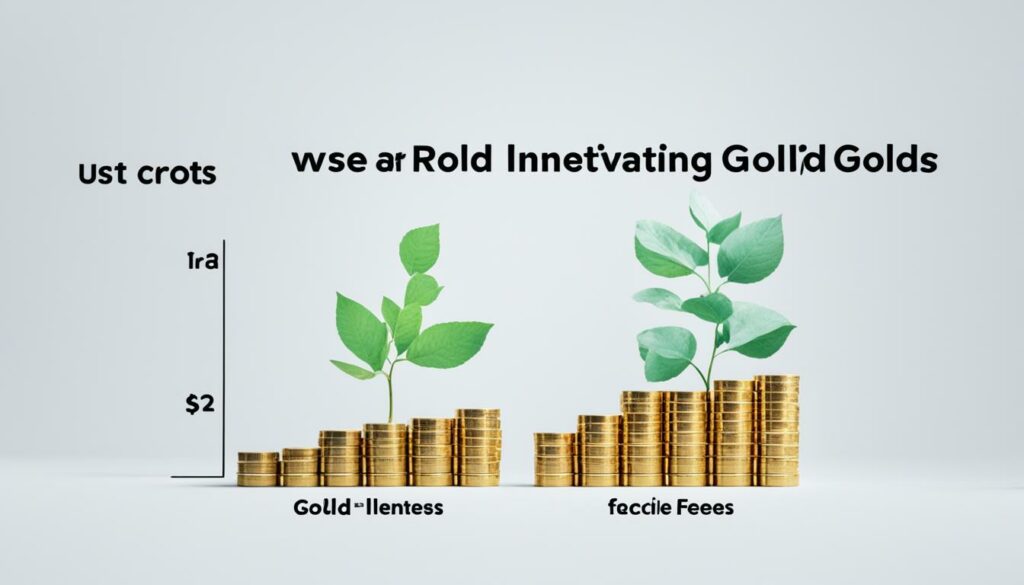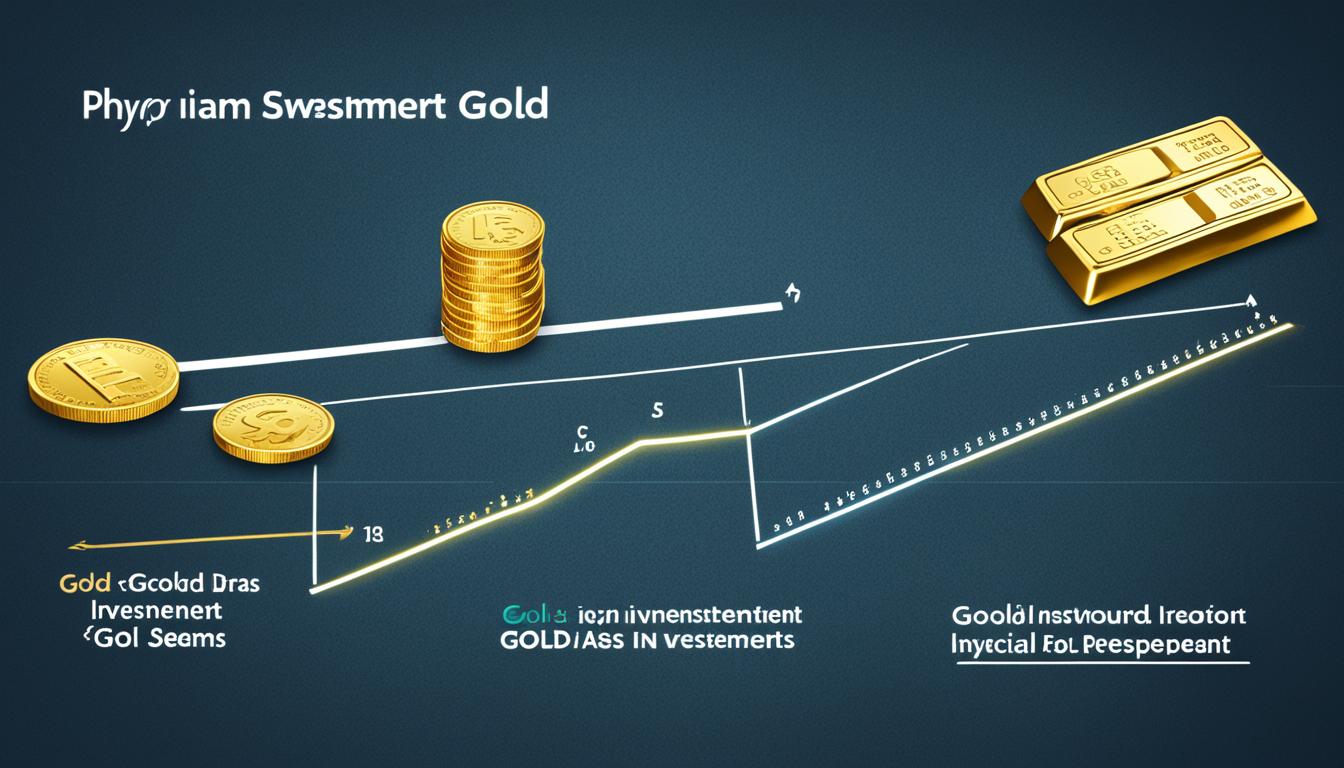Did you know that the worldwide demand for physical gold reached an impressive 4,542.7 tons in 2020? The appeal of gold as a reliable investment during times of economic instability has never been higher. When it comes to investing in gold, should you choose physical gold or a Gold IRA? This detailed guide will analyze the advantages and disadvantages of both choices, giving you valuable information to help you make informed investment choices.
Key Takeaways:
- Investing in physical gold offers tangible ownership and potential value appreciation
- A Gold IRA provides tax advantages and convenience, but with limited control
- Consider diversifying your portfolio with both physical gold and a Gold IRA
- Understand the IRS rules and regulations before investing in gold
- Thoroughly research reputable gold dealers and Gold IRA companies
Overview of Physical Gold Investing
Investing in physical gold involves purchasing tangible forms of the precious metal, such as coins, bars, or jewelry. It offers the benefits of owning a hard asset that holds intrinsic value, tangible ownership and control, and the potential for value appreciation in times of uncertainty.
Physical gold is known for its stability and longevity, making it a popular choice for investors looking to diversify their portfolios. Unlike paper assets, physical gold is a tangible asset that you can hold in your hands, providing a sense of security and ownership.
In addition to its intrinsic value, physical gold has historically shown a tendency for value appreciation. During times of economic turmoil or inflation, gold prices tend to rise, making it an attractive investment for those looking to safeguard their wealth.
However, investing in physical gold comes with its considerations. Researching reputable dealers is crucial to ensure authenticity and avoid counterfeit products. Additionally, storage solutions should be carefully evaluated, taking into account factors such as security, insurance, and accessibility.
“Investing in physical gold provides investors with a tangible asset that holds intrinsic value and can potentially appreciate in value during uncertain times,” says Lawrence – Founder & Lead Strategist at The Liberty Portfolio“
When investing in physical gold, it’s also important to be aware of the tax implications. Capital gains tax may be higher for physical gold when not held within a Gold IRA. Consulting with a tax specialist can help you understand the tax benefits and consequences associated with physical gold investments.
The Tangibility Advantage
One of the most appealing aspects of physical gold investing is the tangible nature of the asset. Unlike stocks, bonds, or other financial instruments, physical gold can be physically held and owned. This tangible ownership provides a sense of control and security that is unmatched by digital or paper assets.
Furthermore, physical gold is universally recognized as a store of value. Throughout history, gold has been valued and accepted as a form of currency and a hedge against economic uncertainty. This perception of value contributes to the potential for long-term value appreciation in physical gold investments.
| Benefits of Physical Gold Investing | Considerations of Physical Gold Investing |
|---|---|
|
|
Overall, investing in physical gold can be a wise decision for those looking to diversify their portfolios and protect their wealth. However, it’s important to carefully weigh the benefits and considerations before making any investment decisions.

As with any investment, it’s recommended to consult with a financial advisor or investment professional who specializes in precious metals. They can provide guidance tailored to your financial goals, risk tolerance, and investment horizon.
Overview of Gold IRAs
A Gold IRA is a tax-advantaged Individual Retirement Account that allows investors to hold physical gold and other IRS-approved precious metals, such as silver, platinum, and palladium. Similar to a traditional IRA, a Gold IRA has unique rules and costs.
Investors interested in a Gold IRA need to open a self-directed IRA with an approved custodian. They must fund the account and direct the custodian to purchase physical bullion. This bullion is then securely stored in an IRS-approved depository.
The benefits of a Gold IRA include tax-deferred growth potential, tax deductions on contributions, and lower taxes on distributions after the age of 59 1/2. It offers investors a way to diversify their retirement savings with precious metals that have historically shown stability and long-term value.
However, investors should be aware of certain limitations and considerations when opting for a Gold IRA. While it provides a tax-advantaged investment opportunity, it also comes with limited control over the physical assets, higher fees compared to traditional IRAs, and strict IRS regulations.
A Gold IRA is a suitable option for individuals looking to include precious metals in their retirement portfolio and take advantage of the potential tax benefits they offer. It allows investors to preserve their wealth in the form of tangible assets and provides an alternative to traditional paper-based investments.

A Gold IRA allows investors to diversify their retirement savings with tax-advantaged exposure to precious metals.
Comparing the Benefits – Physical Gold vs Gold IRA
When comparing the benefits of physical gold and Gold IRAs, investors need to consider various factors that can contribute to their investment decisions. Both options offer unique advantages and disadvantages that align with different investment goals and preferences.
The Benefits of Physical Gold
One of the main benefits of physical gold is direct ownership. When you invest in physical gold, you have tangible control over your investment, without relying on third-party custodians. This ownership gives you the flexibility to store, sell, or trade your gold as you see fit, providing a sense of autonomy and control over your investment strategy.
Furthermore, physical gold offers a range of pricing options, enabling you to take advantage of market fluctuations and timing your purchases or sales more strategically. This flexibility can be particularly beneficial for short-term investors or individuals looking to diversify their investment portfolio with a tangible asset.
In addition, physical gold offers liquidity outside of an IRA. You can easily sell your gold holdings in the open market without the need to liquidate assets within a retirement account. This accessibility can be advantageous for individuals who require immediate cash flow or prefer to have more control over their assets.
The Benefits of Gold IRAs
On the other hand, Gold IRAs offer unique benefits that appeal to long-term investors and individuals seeking tax advantages. A Gold IRA provides tax-deferred growth potential, allowing your investment to grow without being taxed until you start taking distributions. This tax deferral can enhance the overall returns of your investment over time.
Additionally, contributions made to a Gold IRA can be tax-deductible, reducing your taxable income in the year of contribution. This deduction can provide immediate tax benefits and potentially lower your overall tax liability.
Furthermore, Gold IRAs offer lower taxes on distributions after the age of 59 1/2. By converting your gold holdings into cash or other assets, you can take advantage of potentially lower tax rates, optimizing your retirement income.
Considering the Downsides
While physical gold and Gold IRAs have their advantages, it’s essential to be aware of their downsides as well. Physical gold investments are subject to higher capital gains taxes when sold, compared to investments held within an IRA. This tax burden can eat into your overall returns and should be factored into your investment decision.
On the other hand, Gold IRAs come with fees and storage costs. Custodial fees, account setup fees, and annual maintenance fees can impact the overall profitability of your Gold IRA. Additionally, Gold IRAs have limited investment options compared to physical gold investments, restricting your diversification opportunities.
| Benefits | Physical Gold | Gold IRA |
|---|---|---|
| Direct ownership |  |
|
| Pricing options |  |
|
| Liquidity outside of an IRA |  |
|
| Tax-deferred growth potential |  |
|
| Tax deductions on contributions |  |
|
| Lower taxes on distributions after 59 1/2 |  |
Ultimately, the choice between physical gold and a Gold IRA depends on your investment goals, risk tolerance, and personal preferences. It’s crucial to conduct thorough research, consult with financial advisors, and consider your short-term and long-term objectives before making any investment decisions.
IRS Rules and Regulations
To invest in gold properly, it’s important to understand the IRS rules and regulations. When it comes to Gold IRAs, there are specific guidelines that must be followed. These rules require investors to use an approved custodian and storage depository for their gold holdings. Additionally, there are restrictions on the types of gold coins and bars that are allowed in a Gold IRA. It’s crucial to ensure that the gold coins and bars chosen for investment are on the list of IRS-approved options.
Early withdrawals from a Gold IRA before the age of 59 1/2 can result in penalties imposed by the IRS. It’s important to adhere to the rules and avoid these penalties. Additionally, starting at age 72, required minimum distributions must be taken from a Gold IRA according to IRS regulations.
When it comes to physical gold, there are also rules to consider. One notable rule is the higher capital gains tax imposed on the sale of collectible gold, which includes certain types of gold coins and bars. The IRS requires specific reporting for these transactions. It’s important for investors to be aware of these rules and report their transactions accordingly.
“To invest in gold within the guidelines of the IRS rules, investors should work closely with a financial advisor and tax specialist who can provide expert advice and help navigate the complexities of these regulations.” IRA for Gold
By working with the right professionals, investors can optimize their gold investments within the IRS regulations. It’s essential to understand and comply with these rules to ensure a smooth and compliant investment journey.
IRS Rules and Regulations Table
| IRS Rules | Gold IRAs | Physical Gold |
|---|---|---|
| Approved Custodian | Required | N/A |
| Storage Depository | Required | N/A |
| Allowed Coins and Bars | Specific restrictions* | N/A |
| Penalties for Early Withdrawals | Yes | N/A |
| Required Minimum Distributions | Starting at age 72 | N/A |
| Collectible Capital Gains Tax | N/A | Higher |

* IRS-approved gold coins and bars for Gold IRAs vary and may be subject to change. It is important to consult with an approved custodian or financial advisor for the most up-to-date list of allowed options.
Understanding the Costs
Investing in physical gold or Gold IRAs involves various costs that investors should consider when making their investment decisions. These costs can impact the overall returns and profitability of the investment. It’s important to understand and compare the costs associated with both options to make an informed decision.
When purchasing physical gold, investors need to consider premiums over the spot price. Premiums represent the extra amount that investors pay when buying physical gold, and they can vary depending on the type and form of gold purchased. Additionally, there are shipping and insurance costs associated with the transportation and protection of the precious metal. These costs can vary depending on the investor’s location and the value and quantity of gold being transported.

Storage fees are another important cost to consider when investing in physical gold. Proper storage is necessary to ensure the security and integrity of the investment. Investors have a few options for storing their physical gold, such as a safe deposit box, a private vault, or using the services of a precious metals storage company. Each storage option can come with its own associated costs, including monthly or yearly fees.
When it comes to Gold IRAs, investors should consider various fees and costs. These can include account setup fees, annual maintenance fees, transaction fees, brokerage fees, and storage fees. Account setup fees are typically charged by the custodian or broker when setting up a Gold IRA. Annual maintenance fees cover the ongoing management and administration of the account. Transaction fees and brokerage fees may be applicable when buying or selling gold within the IRA, and storage fees cover the cost of storing the physical gold in an IRS-approved depository.
It’s essential for investors to compare these costs and fees associated with physical gold and Gold IRAs to determine which option aligns with their investment goals and financial situation. The costs can vary depending on the specific gold products, dealers, custodians, and storage facilities chosen, so conducting thorough research and due diligence is crucial.
Finding the Best Gold Companies
When it comes to investing in gold, it’s crucial to partner with reputable gold dealers and Gold IRA companies. Conducting thorough due diligence will help ensure that investors work with established and transparent companies that protect their investments and provide a smooth investment process.
Industry reputation is a key factor to consider when choosing a gold company. Look for reputable gold dealers and Gold IRA companies with a track record of delivering quality service and satisfying customers.
Fair pricing and fee structures are another important aspect to evaluate. Compare the pricing structure of different gold dealers and Gold IRA companies to ensure you are getting competitive rates and a transparent fee structure.
Customer reviews and complaints provide valuable insights into the experiences of others who have worked with these companies. Reading customer reviews can help gauge the level of customer satisfaction and identify any potential red flags.
Quick shipping times are essential, especially when purchasing physical gold. Look for gold dealers that offer prompt shipping to ensure you receive your gold in a timely manner.
Secure storage facilities are crucial for Gold IRA companies. Ensure that the company you choose partners with reputable storage facilities that prioritize the safety and security of your precious metals.
Responsive customer support is vital for addressing any concerns or questions you may have during the investment process. Look for gold dealers and Gold IRA companies that offer excellent customer support to ensure a smooth and hassle-free experience.
By considering these key factors – industry reputation, fair pricing and fee structures, customer reviews, shipping times, storage facilities, and customer support – investors can make informed decisions when choosing reputable gold dealers and Gold IRA companies.

Diversify Your Portfolio with Gold
Investors seeking to diversify their portfolios often choose to allocate a portion of their investments to both physical gold and a Gold IRA. This strategic approach allows them to take advantage of the unique benefits of each investment while mitigating the potential downsides.
Working closely with a financial advisor is crucial in determining the ideal allocation of gold based on individual investment goals, risk tolerance, and time horizon. A well-diversified portfolio typically allocates no more than 10-20% of total investments to gold, considering its speculative nature compared to traditional assets like stocks and bonds.
By incorporating gold into their portfolio, investors can achieve a balance between short-term holdings and long-term retirement savings. While physical gold provides a tangible and secure asset, a Gold IRA offers tax advantages and the potential for tax-deferred growth. This diversified approach helps safeguard wealth and provides opportunities for preservation and growth.
Diversifying with gold allows investors to navigate market fluctuations and economic uncertainty, as gold has historically been considered a safe-haven investment. Its value tends to rise during times of financial turbulence, providing a hedge against inflation and currency devaluation.
However, it’s essential to note that investing in gold, whether through physical assets or a Gold IRA, carries its own risks and considerations. Market volatility, storage costs, and liquidity constraints are factors that investors should evaluate when incorporating gold into their portfolio.
Overall, diversifying with gold offers potential benefits in terms of portfolio allocation, long-term retirement savings, and short-term wealth preservation. The key is to carefully assess individual investment objectives and consult with professionals in order to determine the optimal allocation and strategy.
Conclusion
When making gold investment decisions, it’s essential to carefully consider your short-term and long-term goals. Physical gold and Gold IRAs are two popular options that cater to different investment preferences.
For investors looking for shorter-term holdings and direct control over their assets, physical gold is a compelling choice. By purchasing tangible forms of gold like coins, bars, or jewelry, investors gain the advantage of owning a valuable and tangible asset that can potentially appreciate in value during uncertain times.
On the other hand, if your primary focus is long-term retirement savings and tax efficiency, a Gold IRA offers attractive benefits. By opening a self-directed IRA with an approved custodian and purchasing IRS-approved precious metals, such as gold, silver, platinum, or palladium, investors can enjoy tax-deferred growth potential, tax deductions on contributions, and lower taxes on distributions after 59 ½.
However, the ultimate decision doesn’t have to be either/or. Many investors choose to diversify their portfolio by allocating a portion to both physical gold and a Gold IRA. This strategy allows them to benefit from gold across different timeframes and take advantage of the unique perks offered by each option.
It’s important to remember that this article provides valuable insights and guidance, but consulting with financial advisors and tax specialists is crucial before making any investment decisions. They can help you analyze your specific investment goals, time horizon, risk tolerance, and preferences to determine the optimal approach for your portfolio.

By carefully evaluating your investment goals and considering both short-term and long-term perspectives, you can make informed gold investment decisions that align with your financial objectives.
Frequently Asked Questions
1. Can I hold physical gold in a Gold IRA?>
Yes, you can hold physical gold in a Gold IRA. The IRS allows investors to include physical gold, as well as other approved precious metals like silver, platinum, and palladium, in their self-directed IRAs. However, it’s important to work with an approved custodian and store the gold in an IRS-approved depository.
2. What are the tax advantages of a Gold IRA?
A Gold IRA offers several tax advantages. Contributions to a Gold IRA are either tax-deductible or made with pre-tax dollars, depending on the type of IRA. This allows for tax-deferred growth potential, as the earnings in the IRA are not subject to immediate taxation. Additionally, distributions from a Gold IRA after the age of 59 1/2 are subject to lower taxes compared to ordinary income.
3. Are there any risks associated with physical gold or Gold IRAs?
Like any investment, there are risks associated with physical gold and Gold IRAs. Physical gold can be subject to price fluctuations and may not always offer immediate liquidity. Additionally, storing physical gold requires secure storage solutions and may incur additional costs. Gold IRAs, on the other hand, have limitations on the types of gold coins and bars that are allowed, and investors must adhere to IRS rules and regulations.
4. Can I have both physical gold and a Gold IRA in my investment portfolio?
Absolutely. Many investors choose to diversify their portfolios by including both physical gold and a Gold IRA. This strategy allows for the benefits of direct ownership and control over physical gold, while also taking advantage of the tax advantages offered by a Gold IRA. Working closely with a financial advisor can help determine the ideal allocation based on individual investment goals and risk tolerance.
FAQ
What is physical gold investing?
What is a Gold IRA?
What are the benefits of physical gold?
What are the benefits of a Gold IRA?
What are the IRS rules for physical gold and Gold IRAs?
What are the costs associated with physical gold and Gold IRAs?
How can I find reputable gold dealers and Gold IRA companies?
Should I invest in physical gold, a Gold IRA, or both?
Do I need to consult with a financial advisor and tax specialist before investing in gold?
Helen brings a wealth of experience in investment strategy and a deep passion for helping individuals achieve their retirement goals. With a keen understanding of market dynamics, Helen has been instrumental in shaping the vision and direction of Gold IRA Markets. She specializes in creating innovative solutions that align with our clients’ long-term investment objectives.









